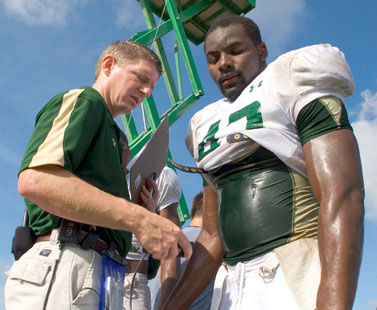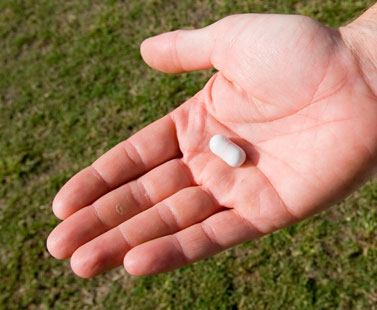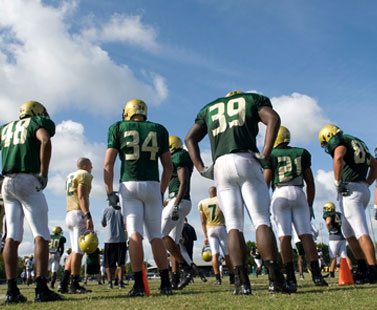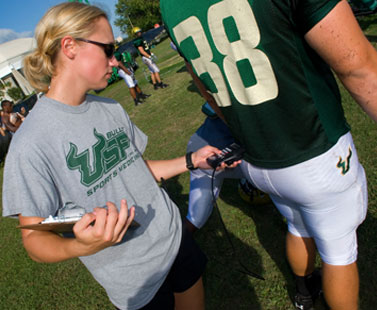What's Your Gut Feeling? You're Too HOT!

At left, Dr. Eric Coris is the Director of Primary Care Sports Medicine for USF and Associate Professor in the USF College of Medicine – Family Medicine and Orthopaedics & Sports Medicine. See Heat Pill Study Video Below.
USF Study to Prevent Heat Illness in Student Athletes May Have Applications Beyond the Playing Field
It’s another hot and humid August morning of preseason practice for the USF Bulls football team. With the sun beating down on the field, the temperature is already 90 degrees Fahrenheit at 9 a.m., and the “feels like” temperature is a sweltering 105 degrees.
Sweat pours off the players wearing heavy pads and helmets as they run, tackle, jump, throw and catch, eager to start a new season of Big East football. On the sidelines, Dr. Eric Coris and the team’s athletic trainers move quickly among some players who have briefly left the field, touching a small data recorder to their lower backs or abdomens. The device reads the internal temperature of players who swallowed a silicone-coated pill the night before. The pill, an ingestible thermometer the size of a large multivitamin, transmits low-frequency magnetic signals from deep within the gut to the data recorder held outside the body.

For the last three years, Dr. Coris, director of Primary Care Sports Medicine at USF Health, has led a cutting-edge research study to help prevent heat illness in athletes. Besides working with football players on the practice field, he has also tested the electronic pill with athletes in the laboratory, where heat and humidity can be carefully controlled.

“Since we began using the pill, we’ve seen a dramatic decrease in the number of players we’ve had to cart off the field to treat with an IV for heat exhaustion and severe body cramps,” said Dr. Coris, a USF Bulls team physician who has received funding from the National Football League, the National Institutes of Occupational Safety and Health, and from USF Health’s Sports Medicine and Athletic-Related Trauma Institute.

The player’s core temperature can be continuously monitored from a personal digital assistant (PDA) on the sidelines. If it creeps up to 103 degrees, the player is pulled from the field, soaked in ice water and given fluids to prevent the progression to potentially life-threatening heat stroke, the most severe form of heat illness. “They usually cool down fairly quickly – within 5 or 10 minutes,” Dr. Coris said. “We don’t want them staying at higher temperatures for long periods.”
Dr. Coris and colleagues have verified some things since starting the heat pill study. They know which types of players are more prone to heat illness – those massive defensive and offensive linemen who pack on the pounds and shoulder a heavy workload are at the top of the list. And despite some earlier debate in the literature, the USF researchers have shown that dehydration is a major risk factor for rising core temperatures and replenishing fluids and electrolytes goes a long way in protecting players from heat illness.

There is more to learn. For instance, why do some high-risk players with elevated core temperatures show no typical heat illness symptoms like headaches, lightheadness, nausea or cramps? Once a higher than normal core temperature is detected, how much time does the athletic training and medical staffs have to intervene before heat illness escalates to the onset of heat stroke? That’s the point at which the body’s organs start shutting down, usually around 105 degrees.
“We’re not sure, and that’s why this research is so important… There’s likely some individual variability in risk based on differences in heat shock protein, Interleukin 6, Interleukin 10, and other factors regulating your ability to tolerate heat,” Dr. Coris said. “We’re continuing to evaluate how typical it is for athletes to get to these high core temperatures, how long they can stay there before showing symptoms, and trying to define the danger point where they go from just being very hot to getting really sick.”
With data collected from the heat pill study this preseason, Dr. Coris is working on fine-tuning a new questionnaire intended to assess heat illness in athletes. The checklist correlates symptoms of heat illness with measures of internal core temperatures. Since the heat pill costs about $40 a pop, the goal is to create a more cost-effective tool that will help identify players who might be most vulnerable.

“A lot of recreational youth sports leagues can’t afford the heat pills, so we have to come up with something to protect the teams without access to the technology,” Dr. Coris said. “We want to help youth football or Little League coaches – using some targeted questions — to predict which kids would be at greatest risk for heat illness problems the next day and intervene before they get into trouble.”
“Over the last two years in Hillsborough County, we lost two teen athletes to heat stroke, so if we could prevent some of those deaths that would be huge.”
Dr. Coris presented the latest USF data incorporated into the heat illness symptom index at the American College of Sports Medicine 2008 Meeting this spring. Once validated, Dr. Coris said, such a checklist would have applications beyond protecting athletes on the practice and playing fields. It could benefit outdoor laborers in Florida or workers in industrial environments where heat is a concern.
USF Athletic Director Doug Woolard said the type of cutting-edge research conducted by Dr. Coris, is a critical part of the partnership bridging USF Health and Athletics as well as the university’s commitment to the well-being of its student athletes. “At first, I don’t think our players knew what to think (about the heat pill),” he said. “Now that they’ve seen their teammates from a preventative standpoint get treated and taken care, they consider it a real benefit.”
Story by Anne Baier, Photography by Eric Younghans/ USF Health Communications
HEAT PILL STUDY VIDEO
[flv]http://www.health.usf.edu/nocms/publicaffairs/now/FLV/DrEricPodcast.flv[/flv]
Other Links:
Photo Gallery 2008
Reporter’s Notebook

